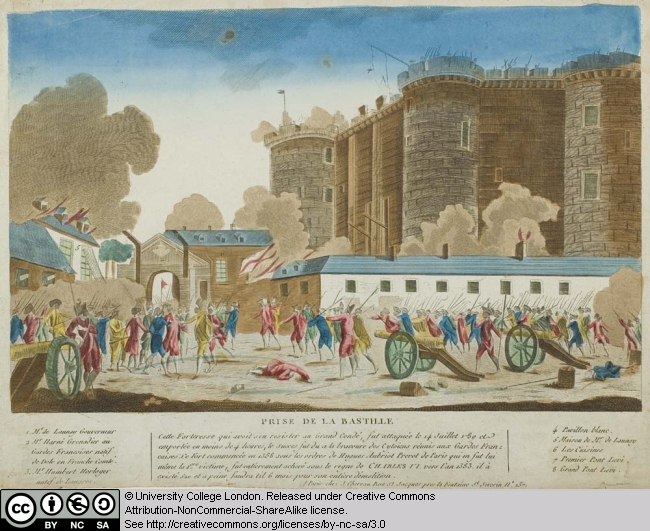3 Capture of the Bastille

Anon
Prise
de la Bastille (The capture of the Bastille) , 1790
Etching
with hand-colouring
Published
by J. Choreau, rue St Jacques près la fontaine St Severin, no. 257, Paris
The text
accompanying the image heroises the achievements of the French civilians and
guard by comparing their swift victory to the failure of Le
Grand Condé (a celebrated seventeenth-century military leader) to capture
the castle. The success of the French civilians is attributed to their
collective bravery, portrayed in the action-packed image, in which the crowd of
courageous French men, armed with guns, bayonets, scythes and pikes, mount
their attack on the Bastille, whose enormous form looms over them. The
prominence of the cannons, billowing clouds of gun smoke and the bodies of
three men in the foreground convey the violence of the episode, which claimed
many lives.
The
printmaker has sought to draw our attention to a drama unfolding in the midst
of this chaotic scene, focusing our attention on the arrest of the Marquis
de Launay, the Governor of the Bastille, by Harné,
a grenadier in the French Guard, and Humbert, a watchmaker. All three are
identified in the key, numbered 1 to 3. Harné and Humbert were often singled
out from amongst their fellow Vainqueurs
de la Bastille (conquerors of the Bastille), for supposedly having been the
first across its drawbridge and for having arrested de Launay (who was
subsequently lynched by the crowd).
The
technical simplicity and crude rendering of this print (note the clumsy
colouring and lack of facial delineation) suggests that it was intended for
speedy production and wide dissemination at minimum cost. Yet its creator was
clearly knowledgeable about the compositional conventions of high art: note,
for example, the figure leaning nonchalantly on a cannon to the left of the
composition. The inclusion of a figure, or a tree, placed at the edge of a
scene was a widely used way of containing the viewer’s attention within the
picture space: such devices are called repoussoirs.
Without doubt this print, produced sometime after the event, would have found a
ready audience. As Rolf Reichardt has noted, such images ‘satisfied the need,
particularly of the simple people […] to relive, in pictorial and oral as well
as written form, the act that had liberated them from an existence of fear and
had given them a sense of being a patriotically unified force.’ [1]
[1] Rolf Reichardt, ‘Prints: Images of the Bastille’, in
Darnton and Roche (ed.), Revolution
in Print: The Press in France, 1775 – 1800,
Licensed under the Creative Commons Attribution Non-commercial Share Alike 3.0 License
This resource has been released as an open educational resource (OER) on a Creative Commons 'Attribution Non-commercial Share Alike' license. This means that once downloaded, content can be modified and improved to complement a particular course. This requires, however, that improvements are recycled back into the OER community. All content present at the time of download must be accordingly credited and, in turn, novel content must be appropriately licensed.